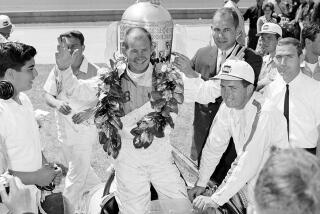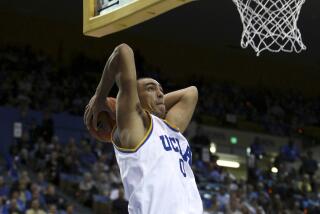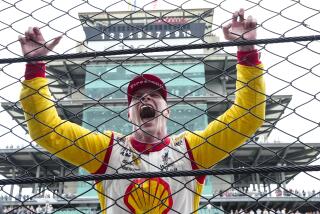He’s Ready to Crash the Indy 500’s Party : Auto racing: Despite his 12 wrecks for Foyt last year, don’t call Gordon careless--or carless.
- Share via
INDIANAPOLIS — Even though Robby Gordon crashed A.J. Foyt’s cars on 12 occasions last season--including one wreck at Indianapolis that caused Foyt to retire on the spot--he resents having the reputation of a car crasher.
The 25-year-old Southern Californian says Foyt did not provide him with the proper opportunity to develop his obvious talent for driving fast, a circumstance he says he is getting this year with Derrick Walker, a soft-spoken Scotsman who approaches racing with a more professorial attitude than the quick-tempered Foyt.
“Last year was my first real season in Indy cars, and when you want to climb to the next ladder, without a backup car and without testing, you’ve got to run over your head now and then,” Gordon said. “I never felt I was getting the same opportunity as the drivers on some of the other teams.
“You know, I’ve won (off-road races in) Baja (California), driving by myself one time, and you don’t win down there, where there is liable to be something around the corner on every turn, without knowing how to save the equipment.”
Gordon drove 17 hours solo in a Ford truck and won the Baja 1000 off-road race in 1989, a feat that caught the eye of Ford racing executives and led to his first Indy car ride. “I don’t want anyone to think I didn’t learn a lot from him, I did,” Gordon said of his year with Foyt. “But it was tough, real tough. I’ll say this, though, I’m the only driver who has made it through a whole year with A.J.”
Since 1990, when Foyt suffered shattered feet in a crash at Elkhart Lake, Wis., and began putting other drivers in his No. 14 car, the list has included Al Unser, Mike Groff, Ross Cheever, Bernard Jourdain, Jeff Andretti, Brian Bonner, Didier Theys, Gregor Foytek, Jan Beekhuis, Davy Jones--who was let go last week--and now Brian Herta, his current driver.
“Most of them didn’t last more than a race or two, so I feel pretty good about my record,” Gordon said.
Gordon’s brush with the Indianapolis Motor Speedway wall last May 15--the one that triggered Foyt’s retirement--occurred during morning practice before the first qualifying session. Foyt was on the track at the time but when Gordon hit the wall for the second time in two days, Foyt pulled into the pits, took off his helmet and said he was through with race car driving.
“I can’t run a team the way it ought to be run and still be on the track myself, so I’m calling it quits,” the four-time 500 winner said.
Then he grounded Gordon for four days.
“In a way, we were probably good for each other,” Gordon said. “I think he likes someone who’s not afraid to voice an opinion. When I told him I wasn’t happy, he didn’t like it, but I think he respected my saying it.”
In 15 races, Gordon had 10 finishes in the top 10, including a second at Mid-Ohio and a third in the season opener in Australia.
When Al Unser Jr. left the Galles team and the Valvoline sponsorship at the end of the season, it set in motion a series of events that led to Gordon’s moving to Walker’s team. Valvoline chose to sponsor one of Walker’s cars, with the stipulation that he have an American driver. Canadian Scott Goodyear had been Walker’s driver.
“When Derrick called, I contacted Parnelli Jones about whether I should make the move or not,” Gordon said. “Parnelli had raced with my dad (off-road racing champion Bob Gordon) for years and I knew him pretty well. He told me it was a good opportunity. I knew that Walker had helped Rick Mears make the move from desert racing to Indy cars, so I bought out my contract from A.J.”
Walker was a crewman with Roger Penske’s team when Mears took his Indy car driver’s test at Phoenix in 1977 and was Penske’s crew chief when Mears won his four Indy 500s.
“They aren’t much alike except for their feel for the car,” Walker said. “Robby is more of a risk taker, where Rick was very calculating, more of a controlled individual. We are beginning to see some patience in Robby, but he has a ways to go before he has a handle on it.
“We don’t want to stifle his risk taking, but we want to temper it. If it stops him from winning races, it’s bad. But if taking a few risks is what he needs to win, we’ll let him go.
“The most impressive thing about Robby, and remember he has very limited experience in open-wheel cars, is his ability to always have something in reserve. Just when you think he is running at the car’s limit, he can step up to another level. What he’s got to learn is not to try it every single lap. Overall, I have been pleased with his progress.”
Gordon says his four months with Walker have given him a new outlook on Indy car racing.
“People said I was too hot-headed with A.J., but Derrick says I am one of the calmest drivers he’s known,” Gordon said. “He says my voice never sounds excited, or out of control, during a race.
“We talk a lot, because he is a great strategist. He knows how to play the game as the race is being run, and that’s something I need. He is like Penske and some of the guys like that who try to outsmart the opposition as well as outrun them.”
Gordon has been a factor of sorts in all three Indy car races this season. He ran among the leaders in each and might have won at Phoenix had he not run out of fuel while in the lead, 13 seconds ahead of eventual winner Emerson Fittipaldi.
“We didn’t get all the fuel in on our first pit stop and the difference was not much more than a gallon, but that was enough,” Gordon said. “Emmo (Fittipaldi) would probably have taken the lead back when we pitted, but we were running him down. I ran Phoenix like I used to run Baja--stay in sight of the leaders, don’t jeopardize the car by over-driving and race for the finish--but then the gas ran out.
“With just a tiny bit of luck and a caution flag at the right time, we’d have had a win. We definitely had a car that could have won. I stayed out of the Villeneuve-Matsushita accident by being extra careful when I went by it.”
At Long Beach, Gordon finished third, 42 seconds behind winner Al Unser Jr. after leading briefly in mid-race. “Derrick has made me feel more a part of the team than I did with Foyt,” Gordon said. “The crew works really well together and we hang out together. I look after them, and they look after me.”
A crew can make a difference in the race, too, Gordon said.
“The average pit stop with Foyt was 22 seconds,” he said. “Derrick’s crew can get me out in 13 seconds. That’s a nine-second shift, and that’s an awful lot of time to try and make up on the track when cars are as competitive as they are today.”
Gordon moved into the top 10 practice lap leaders Tuesday with a lap at 225.129 m.p.h.
More to Read
Go beyond the scoreboard
Get the latest on L.A.'s teams in the daily Sports Report newsletter.
You may occasionally receive promotional content from the Los Angeles Times.










